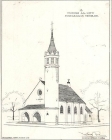Our Town Town Monor is situated between Danube and Tisza rivers, approx. 30 km far to south-east from Budapest. The international airport of Hungary is not more than 25 km far from Monor. The geometric centre of the present Hungary, Pusztavacs is less than 20 km far from Monor. You can arrive here by car or train, because the highway No 4 and the railway line No 100 cross our town. Town Monor is situated between Danube and Tisza rivers, approx. 30 km far to south-east from Budapest. The international airport of Hungary is not more than 25 km far from Monor. The geometric centre of the present Hungary, Pusztavacs is less than 20 km far from Monor. You can arrive here by car or train, because the highway No 4 and the railway line No 100 cross our town.
Visitors often meet the names „Strázsa” (Guard) and „Forrás” (Spring) at every step. Strázsa is one of the southest „peak” of the North-Mounts of Hungary at the northern border of Monor. Forrás is the only locally-protected area of the town. Strázsa certainly is not a real mount, even not a hill because the height of it is only 191 m. Hill or mountain? The category is not significant but our Strázsa-hill is really important, because it is one of the southest points of Gödöllõ-Monor Hills, Northern Mounts of Hungary and the whole North-West Carpathians.
So, Monor is situated – according to the geographers – on the area where the Carpathians and Alföld (flat area) meet. Traditions say that during Turkish occupation the guards watched enemy from Strázsa hill. Basic soil of the hill is loess. Cellars were built in it, walls of houses were made from it, moreover excellent quality soil on some areas was formed on loess. Also mammoth remains were found on Strázsa hill. Inner area of the town is situated on Alföld where fine sand coming from Danube covers surface. Alföld is not a sea-flat area – like the Hungarian poet Sándor Petõfi has written in his several poems – but an unperfect flat with small hills and depressions. Monor – as said - is situated on seven hills – like Rome. In spring inland waters come and cover a part of the country while the other part comes out far from the water.
Region of Forrás was declared as a locally protected area in 1993. On fields you can find water-demanding willow groves, and reeds on the deepest point of the valley. Special representatives of soft-stem plants are common marsh marigold and common comfrey. Plants of hills consist of dry grass and shrubbery. Protected plant of steppe grass is „Budai” centaurea. There are thorn-bush, euonymus, wild rose and sloe-bush. In the past, water volume of the region „Forrás” – which is being fed by inland water – increased thanking to bigger rains and snow-melting established a no-outlet marsh in the direct region. But in the last decades extreme dryness came and little-water demanding willows took over the place of reeds, bulrush and other marsh plants. During excursions you can meet also some representatives of fauna. Lizards and some kinds of frogs live here. You can find birds - golden oriole, nightingale and forest finch – and mammals – field rabbit and deer.
No such natural vegetation and fauna can be found on other parts of Monor. Not far from Monor (between Csévharaszt and Nyáregyháza) one of the most beautiful sandy forest-steppe areas of the country is situated. In olden times these forest steppes were found on the whole area of Monor, but in the last two centuries plough-lands, vine and fruit plants and biologically low-value planted forests changed the old vegetation. Since stopping large-scale extensive farming, vegetation similar to the original one and some kinds of animals have started to return. You can see again spermophiles and lanners, hunting for them. Not exactly 20 000 inhabitants live in Monor and Monorierdõ. Centre, called „city” by the inhabitants has got a real small-town atmosphere which was perpetuated by film producers in the past, coming here to make films.
In the last centuries Monor was declared „town” three times. Last – hopefully the final - declaration dated in 1989. Monor is the centre of its region. Two secondary schools, a health centre, a music school, a museum of local history and a fire station serve also people of Monor’s region. Monor is a quiet small town. Perhaps this is why a lot of people move here from big cities, first of all Budapest. Our community programs have been visited by inhabitants of Monor as well as its region. For example Carnival and school dances, in spring occasions of Monor May Days, sport events, Orban day program in honour of new wine and vintaging parade in autumn.
Monor was 600 years old in 1998. On this occasion a book „Monor Chronicle” was published. In this book you can read detailed information about history, geography and people of Monor. Here below there is some idea and a part from the book: „ It’s an imposing feeling to think of our past, to listen to how our ancients lived, worked for theirselves and the community. Also they were flesh-blood people, were successful or not too successful, but not this is the most important! But they made efforts to find as many meeting points of people as possible. This is also our task to make a good community and to do our best together for our town! If these connections are successful our town develop and this is good also for individuals. Appreciation to our Ancients, working in the past for our present! Our task is to consider the past when thinking of our present and the future to be built up.”
|
